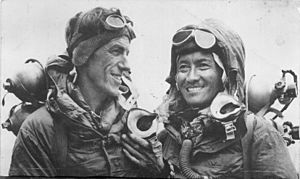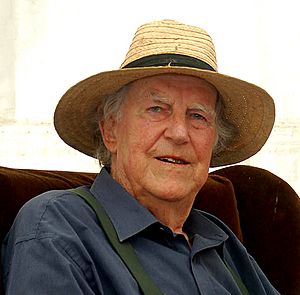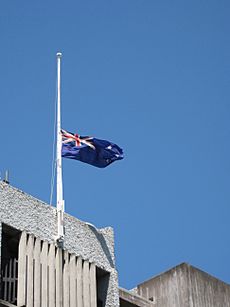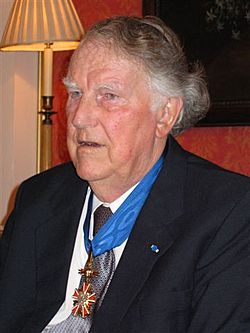Edmund Hillary facts for kids
Quick facts for kids
Sir Edmund Hillary
KG ONZ KBE
|
|
|---|---|
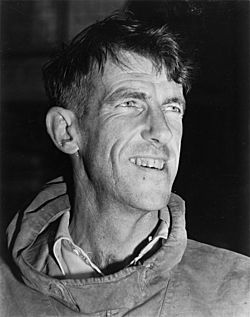
Edmund Hillary in the early 1950's
|
|
| Born |
Edmund Percival Hillary
20 July 1919 Auckland, New Zealand
|
| Died | 11 January 2008 (aged 88) Auckland, New Zealand
|
| Cause of death | Myocardial infarction |
| Spouse(s) | Louise Mary Rose (1953-1975) June Mulgrew, QSM (1989-2008) |
| Children | Peter (1954) Sarah (1955) Belinda (1959-1975) |
| Parent(s) | Percival Augustus Hillary Gertrude Hillary, née Clark |
Sir Edmund Hillary, (born 20 July 1919, died 11 January 2008) was a New Zealand mountaineer and explorer. He and Sherpa guide Tenzing Norgay were the first people to climb Mount Everest. They got to the top on 29 May 1953. Mount Everest is the tallest mountain on Earth. During his teenage years, Hillary had attended Auckland Grammar School.
Sir Edmund Hillary's fame came as a result of being the first New Zealander in the world to conquer Mt. Everest in Nepal. He is on the New Zealand five dollar note. He also climbed ten other mountains after Mount Everest, all of which are also in the Himalayas.
Contents
Early life
Hillary was born to Percival Augustus Hillary and Gertrude Hillary, née Clark, in Auckland, New Zealand, on 20 July 1919. His family moved to Tuakau (south of Auckland) in 1920, after his father (who served at Gallipoli) had gotten land there. His grandparents were early settlers in northern Wairoa in the mid 19th century after moving from Yorkshire, England.
Hillary learned at Tuakau Primary School and then Auckland Grammar School. He finished primary school two years early, but he did not do very well at high school. At first, he was smaller than other students there and very shy so he felt safe with his books and often thought of a life filled with adventure. Every day, he rode a train to and from high school, and he often used this time to read. Learning how to box helped him become more confident. At age 16 his interest in climbing started during a school trip to Mount Ruapehu. Although very tall at 6 ft 5 in (195 cm), he was stronger than many of his fellow hikers. He learned about mathematics and science at The University of Auckland, and in 1939 he completed his first important climb, which was reaching the top of a mountain called Mount Ollivier. With his brother Rex, Hillary became a beekeeper during summertime, which allowed him to do climbing in the winter.
Personal life

Hillary married Louise Mary Rose on 3 September 1953, soon after the ascent of Everest. A shy man, he relied on his future mother-in-law to propose on his behalf. They had three children: Peter (born 1954), Sarah (born 1955) and Belinda (1959–1975). In 1975 while en route to join Hillary in the village of Phaphlu, where he was helping to build a hospital, Louise and Belinda were killed in a plane crash near Kathmandu airport shortly after take-off. In 1989 he married June Mulgrew, the widow of his close friend Peter Mulgrew, who died having replaced Hillary as speaker on Air New Zealand Flight 901, a sightseeing flight to the Antarctic which crashed into Mount Erebus in 1979. His son Peter Hillary has also become a climber, summiting Everest in 1990. In May 2002 Peter climbed Everest as part of a 50th anniversary celebration; Jamling Tenzing Norgay (son of Tenzing; Tenzing himself had died in 1986) was also part of the expedition. Hillary is also survived by six grandchildren.
He spent most of his life (when not away on expeditions) living in a property on Remuera Road in Auckland City, where he enjoyed reading adventure and science fiction novels in his retirement.
Hillary also built a bach at Whites Beach, one of Auckland's west coast beaches in the former Waitakere City, between Anawhata and North Piha. Bob Harvey, mayor of Waitakere, and friend of Hillary from the early 1970s, said that "the West Coast was Sir Ed's second home. Anawhata was his favourite beach; a place he called the most beautiful on the planet." Harvey said that the bach was Hillary's place of solace, where he would go when the media attention became too much – including after his return from conquering Everest. "Building the cottage at Whites Beach – he told me – was one of his greatest pleasures." Aside from the bach, Hillary also co-owned a large piece of land in Karekare Valley in the 1970s with fellow climber Mike Gill.
The Hillary family has had a connection with the West Coast of Auckland since 1925, when Hillary's father-in-law, Jim Rose, built a bach at Anawhata. The family donated land at Whites Beach that is now crossed by trampers on the Hillary Trail, named for Edmund.
World War II
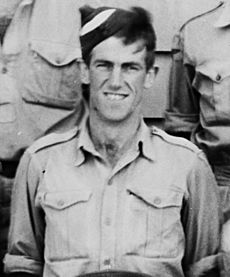
Upon the outbreak of World War II, Hillary applied to join the Royal New Zealand Air Force (RNZAF) but withdrew the application before it was considered, because he was "harassed by [his] religious conscience". In 1943, the Japanese threat in the Pacific and the arrival of conscription finally undermined his pacifist inclination; Hillary joined the RNZAF as a navigator serving in No. 6 Squadron RNZAF and then No. 5 Squadron RNZAF on Catalina flying boats. In 1945, he was sent to Fiji and to the Solomon Islands, where he was badly burnt in a boat accident and repatriated to New Zealand.
Expeditions
On 30 January 1948, Harry Ayres, along with Mick Sullivan, led Hillary and Ruth Adams up the south ridge of Aoraki / Mount Cook, New Zealand's highest peak.
In 1951, Hillary was part of a British reconnaissance expedition to Everest led by Eric Shipton, before joining the successful British attempt of 1953. In 1952, Hillary and George Lowe were part of the British team led by Eric Shipton, that attempted Cho Oyu. After that attempt failed due to the lack of route from the Nepal side, Hillary and Lowe crossed the Nup La into Tibet and reached the old Camp II, on the northern side, where all the pre-war expeditions camped.
1953 Everest expedition
The route to Everest was closed by Chinese-controlled Tibet, and Nepal allowed only one expedition per year. A Swiss expedition (in which Tenzing took part) had attempted to reach the summit in 1952, but was turned back from the summit by bad weather and exhaustion 800 feet (240 m) below the summit. During a 1952 trip in the Alps, Hillary discovered that he and his friend George Lowe had been invited by the Joint Himalayan Committee for the approved British 1953 attempt and immediately accepted.
Shipton was named as leader but was replaced by Hunt. Hillary considered pulling out, but both Hunt and Shipton talked him into remaining. Hillary was intending to climb with Lowe, but Hunt named two teams for the assault: Tom Bourdillon and Charles Evans; and Hillary and Tenzing. Hillary, therefore, made a concerted effort to forge a working friendship with Tenzing.
The Hunt expedition totalled over 400 people, including 362 porters, 20 Sherpa guides, and 10,000 lbs of baggage, and like many such expeditions, was a team effort. Lowe supervised the preparation of the Lhotse Face, a huge and steep ice face, for climbing. Hillary forged a route through the treacherous Khumbu Icefall.
The expedition set up base camp in March 1953 and, working slowly, set up its final camp at the South Col at 25,900 feet (7,890 m). On 26 May, Bourdillon and Evans attempted the climb but turned back when Evans' oxygen system failed. The pair had reached the South Summit, coming within 300 vertical feet (91 m) of the summit. Hunt then directed Hillary and Tenzing to go for the summit.
Snow and wind held the pair up at the South Col for two days. They set out on 28 May with a support trio of Lowe, Alfred Gregory, and Ang Nyima. The two pitched a tent at 27,900 feet (8,500 m) on 28 May, while their support group returned down the mountain. On the following morning Hillary discovered that his boots had frozen solid outside the tent. He spent two hours warming them before he and Tenzing, wearing 30-pound (14 kg) packs, attempted the final ascent. The crucial move of the last part of the ascent was the 40-foot (12 m) rock face later named the "Hillary Step". Hillary saw a means to wedge his way up a crack in the face between the rock wall and the ice, and Tenzing followed. From there the following effort was relatively simple. Hillary reported that both men reached the summit at the same time, but in The Dream Comes True, Tenzing said that Hillary had taken the first step atop Mount Everest. They reached Everest's 29,028 ft (8,848 m) summit, the highest point on earth, at 11:30 am. As Hillary put it, "A few more whacks of the ice axe in the firm snow, and we stood on top."
They spent only about 15 minutes at the summit. Hillary took the famous photo of Tenzing posing with his ice-axe, but Hillary's ascent went unrecorded. BBC News attributed this to Tenzing's having never used a camera, but according to Tenzing's autobiography, Man of Everest, when Tenzing offered to take Hillary's photograph Hillary declined: "I motioned to Hillary that I would now take his picture. But for some reason he shook his head; he did not want it", Tenzing wrote. Tenzing left chocolates in the snow as an offering, and Hillary left a cross that he had been given by John Hunt. Additional photos were taken looking down the mountain, to confirm that they had made it to the top and that the ascent was not faked.
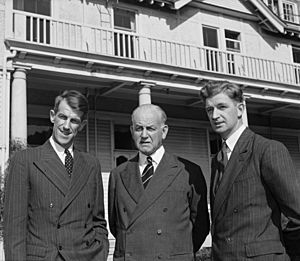
The two had to take care on the descent after discovering that drifting snow had covered their tracks, complicating the task of retracing their steps. The first person they met was Lowe, who had climbed up to bring them hot soup.
News of the expedition reached Britain on the day of Queen Elizabeth II's coronation, and the press called the successful ascent a coronation gift. In return, the 37 members of the party received the Queen Elizabeth II Coronation Medal with MOUNT EVEREST EXPEDITION engraved on the rim. The group was surprised by the international acclaim they received upon arriving in Kathmandu. Hillary and Hunt were knighted by the young queen, while Tenzing – ineligible for knighthood as a Nepalese citizen – received the George Medal from the British Government for his efforts with the expedition.
After Everest
Hillary climbed ten other peaks in the Himalayas on further visits in 1956, 1960–1961, and 1963–1965. He also reached the South Pole as part of the Commonwealth Trans-Antarctic Expedition, for which he led the New Zealand section, on 4 January 1958. His party was the first to reach the Pole overland since Amundsen in 1911 and Scott in 1912, and the first ever to do so using motor vehicles.
Hillary narrowly missed becoming a victim in TWA Flight 266 from the American midwest in the 1960 New York air disaster, having been late for his flight.
In the summer of 1962, he was a guest on the television show What's My Line?. The panellists were blindfolded for his appearance. He stumped the panel, comprising Dorothy Kilgallen, guest panelist Merv Griffin, Arlene Francis, and Bennett Cerf.
In 1977, he led a jetboat expedition, titled "Ocean to Sky", from the mouth of the Ganges River to its source. Between 1977 and 1979, Hillary commentated aboard several Antarctic sightseeing flights operated by Air New Zealand. He was scheduled to commentate on 28 November 1979 Air New Zealand Flight 901, but had to pull out due to work commitments in the United States and was replaced by his close friend Peter Mulgrew. The aircraft crashed into Mount Erebus in Antarctica, killing all 257 on board. Hillary later married Mulgrew's widow.
In 1985, he accompanied Neil Armstrong in a small twin-engined ski plane over the Arctic Ocean and landed at the North Pole. Hillary thus became the first man to stand at both poles and on the summit of Everest.
Hillary was highly critical of a decision not to try to rescue David Sharp (an Everest climber who died on the mountain in 2006), saying that leaving other climbers to die is unacceptable, and the desire to get to the summit has become all-important. He also said, "I think the whole attitude towards climbing Mount Everest has become rather horrifying. The people just want to get to the top. It was wrong if there was a man suffering altitude problems and was huddled under a rock, just to lift your hat, say good morning and pass on by." He also told the New Zealand Herald that he was horrified by the callous attitude of today's climbers, "I think that their priority was to get to the top and the welfare of ... a member of an expedition was very secondary."
Australian mountaineer Adam Darragh, in turn, considered Hillary's criticism of expedition leader Russell Brice and his team as too harsh. Mark Inglis, while maintaining that he remained on good terms with Hillary after the incident, noted that Sharp was "almost frozen solid" and "effectively dead" when the team found him in the difficult terrain on their descent.
In January 2007, Hillary travelled to Antarctica to commemorate the 50th anniversary of the founding of Scott Base. He flew to the station on 18 January 2007 with a delegation including the Prime Minister. While there he called for the British government to contribute to the upkeep of Robert Falcon Scott's and Ernest Shackleton's huts.
On 22 April 2007, while on a trip to Kathmandu, Hillary was reported to have suffered a fall. There was no comment on the nature of his illness, and he did not immediately seek treatment. He was hospitalised after returning to New Zealand.
Public recognition
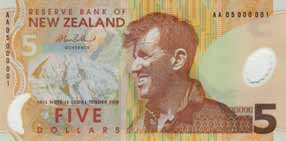
On 6 June 1953 Hillary was appointed Knight Commander of the Order of the British Empire and received the Queen Elizabeth II Coronation Medal the same year; and on 6 February 1987 was the fourth appointee to the Order of New Zealand. On 22 April 1995 Hillary was appointed Knight Companion of The Most Noble Order of the Garter. The Government of India conferred on him its second highest civilian award, the Padma Vibhushan, posthumously, in 2008. He was also awarded the Polar Medal in 1958 for his part in the Commonwealth Trans-Antarctic Expedition, and the Order of Gorkha Dakshina Bahu, 1st Class of the Kingdom of Nepal in 1953 and the Coronation Medal in 1975. On 17 June 2004 Hillary was awarded Commander's Cross of the Order of Merit of the Republic of Poland.
To mark the occasion of the 50th anniversary of the first successful ascent of Everest the Nepalese government conferred honorary citizenship upon Hillary at a special Golden Jubilee celebration in Kathmandu, Nepal. He was the first foreign national to receive that honour.

In 1992 Hillary appeared on the updated New Zealand $5 note, thus making him the only New Zealander to appear on a banknote during his or her lifetime, in defiance of the established convention for banknotes of using only depictions of deceased individuals, and current heads of state. The Reserve Bank governor at the time, Don Brash, had originally intended to use a deceased sportsperson on the $5 note but could not find a suitable candidate. Instead he broke with convention by requesting and receiving Hillary's permission – along with an insistence from Hillary to use Aoraki/Mount Cook rather than Mount Everest in the backdrop. The image also features a Ferguson TE20 tractor like the one Hillary used to reach the South Pole on the Commonwealth Trans-Antarctic Expedition.
In 2005 a poll conducted by Reader's Digest put Hillary as "New Zealand's most trusted individual", beating cyclist Sarah Ulmer and film director Peter Jackson. He kept the title in 2006 and 2007 After his death in 2008 he was succeeded by Willie Apiata VC, a Corporal in the NZSAS.
Hillary's favoured New Zealand charity was the Sir Edmund Hillary Outdoor Pursuits Centre, of which he was patron for 35 years. He was particularly keen on the work this organisation did in introducing young New Zealanders to the outdoors in a very similar way to his first experience of a school trip to Mt Ruapehu at the age of 16. A 2.3-metre (7.5 ft) bronze statue of "Sir Ed" is installed outside The Hermitage Hotel at Mount Cook Village; it was unveiled by Hillary himself in 2003. Various streets, schools and organisations around New Zealand and abroad are named after him. A few examples are Hillary College (Otara), Edmund Hillary Primary School (Papakura) and the Hillary Commission (now SPARC). Several schools have houses named after him, including Auckland Grammar School, Edgecumbe College, Hutt International Boys' School, Macleans College, Rangiora High School, Tauranga Boys' College and Upper Hutt College.
Two Antarctic features are named after Hillary. The Hillary Coast is a section of coastline south of Ross Island and north of the Shackleton Coast. It is formally recognised by New Zealand, the United States of America and Russia. The Hillary Canyon, an undersea feature in the Ross Sea appears on the General Bathymetric Chart of the Oceans, which is published by the International Hydrographic Organization.
Philanthropy
Following his ascent of Everest he devoted much of his life to helping the Sherpa people of Nepal through the Himalayan Trust, which he founded in 1960 and led until his death in 2008. Through his efforts many schools and hospitals were built in this remote region of the Himalayas. He was the Honorary President of the American Himalayan Foundation, a United States non-profit body that helps improve the ecology and living conditions in the Himalayas. He was also the Honorary President of Mountain Wilderness, an international NGO dedicated to the worldwide protection of mountains.
Political involvement
Hillary took part in the 1975 New Zealand general election, as a member of the "Citizens for Rowling" campaign. His involvement in this campaign was seen as precluding his nomination as Governor-General, which position was instead offered to Keith Holyoake in 1977. However, in 1985, Hillary was appointed New Zealand High Commissioner to India (concurrently High Commissioner to Bangladesh and Ambassador to Nepal) and spent four and a half years based in New Delhi.
Death
On 11 January 2008, Hillary died of heart failure at the Auckland City Hospital at the age of 88. Hillary's death was announced by New Zealand Prime Minister Helen Clark at around 11:20 am. She stated that his death was a "profound loss to New Zealand". His death was recognised by the lowering of flags to half-mast on all Government and public buildings and at Scott Base in Antarctica. Actor and adventurer Brian Blessed, who attempted to climb Everest three times, described Sir Edmund as a "kind of titan". Hillary was in hospital at the time of his death but was expected to come home that day according to his family.
After Hillary's death the Green Party proposed a new public holiday for 20 July or the Monday nearest to it. Renaming mountains after Hillary was also proposed. The Mt Cook Village's Hermitage Hotel, the Sir Edmund Hillary Alpine Centre and Alpine Guides, proposed a renaming of Mount Ollivier, the first mountain climbed by Hillary. The family of Arthur Ollivier, for whom the mountain is named, are against such a renaming.
Funeral
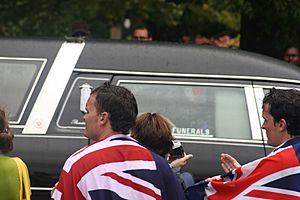
A state funeral was held for Hillary on 22 January 2008, after which his body was cremated. The first part of this funeral was on 21 January when Hillary's casket was taken into Holy Trinity Cathedral to lie in state. On 29 February 2008, in a private ceremony, most of Hillary's ashes were scattered in Auckland's Hauraki Gulf as he had desired. The remainder went to a Nepalese monastery near Everest; a plan to scatter them on the summit was cancelled in 2010.
On 2 April 2008, a service of thanksgiving was held in his honour at St George's Chapel in Windsor Castle. It was attended by the Queen (but not the Duke of Edinburgh owing to a chest infection) and New Zealand dignitaries including Prime Minister Helen Clark. Sir Edmund's family and family members of Tenzing Norgay attended as well. Gurkha soldiers from Nepal, a country Sir Edmund Hillary held much affection for, stood guard outside the ceremony.
On 5 November 2008, a commemorative set of five stamps was issued.
Legacy
- The Sir Edmund Hillary Mountain Legacy Medal, awarded by the Nepalese NGO Mountain Legacy "for remarkable service in the conservation of culture and nature in mountainous regions" was inaugurated in 2003, with the approval of Sir Edmund Hillary.
- A bronze bust of Hillary (circa 1953) by Ophelia Gordon Bell is in the Te Papa museum in Wellington, New Zealand.
- Hillary Montes, the second-highest mountain range on Pluto, is named in honour of Edmund Hillary.
- The Sir Edmund Hillary Archive was added to the UNESCO Memory of the world archive in 2013, it is currently held by the Auckland War Memorial Museum
Interesting facts about Edmund Hillary
- Edmund Hillary was also a beekeeper.
- In 1960 he was part of an expedition to look for the Yeti (abominable snowman), a being thought to live in the Himalayas.
- When discussing the Yeti he said “The yeti is not a strange, superhuman creature as has been imagined. We have found rational explanations for most yeti phenomena.”
- Edmund Hillary was 6ft, 5 inches tall.
- Hillary’s middle name was Percival.
- His first wife and daughter Belinda died in a plane crash in 1975.
Edmund Hillary quotes
- "It is not the mountain we conquer but ourselves."
- "Life's a bit like mountaineering - never look down."
- "With practice and focus, you can extend yourself far more than you ever believed possible."
- "You don't have to be a hero to accomplish great things...to compete. You can just be an ordinary chap, sufficiently motivated to reach challenging goals."
Images for kids
See also
 In Spanish: Edmund Hillary para niños
In Spanish: Edmund Hillary para niños


